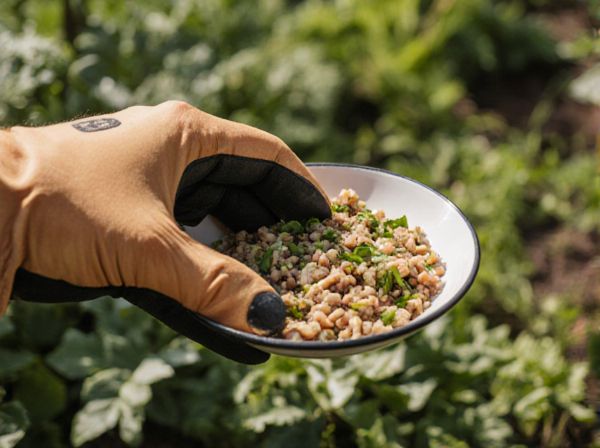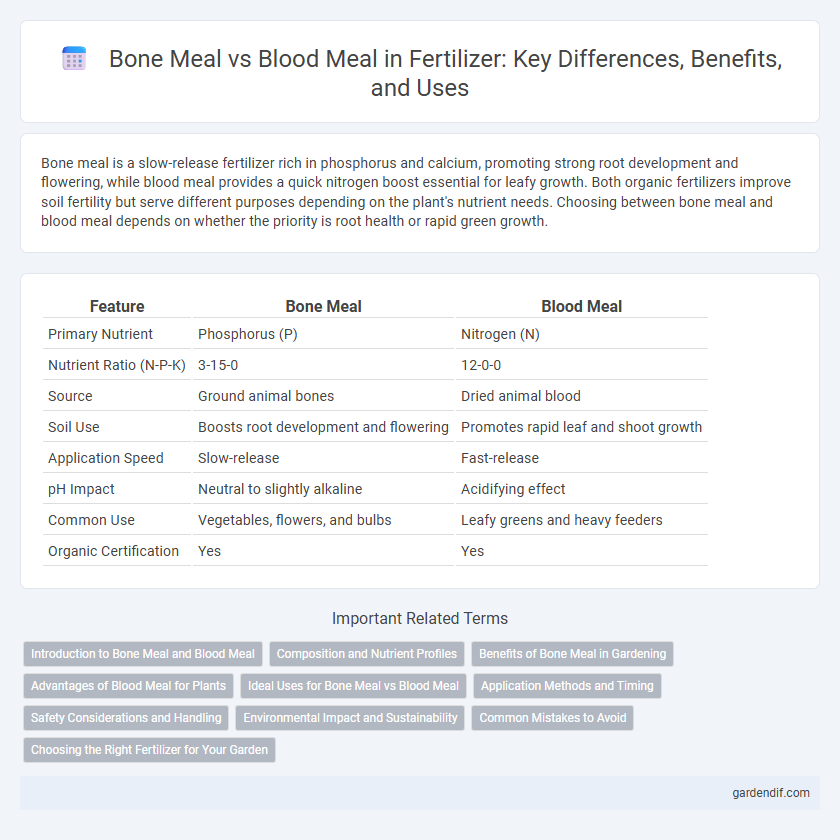
Bone meal vs Blood meal Illustration
Bone meal is a slow-release fertilizer rich in phosphorus and calcium, promoting strong root development and flowering, while blood meal provides a quick nitrogen boost essential for leafy growth. Both organic fertilizers improve soil fertility but serve different purposes depending on the plant's nutrient needs. Choosing between bone meal and blood meal depends on whether the priority is root health or rapid green growth.
Table of Comparison
| Feature | Bone Meal | Blood Meal |
|---|---|---|
| Primary Nutrient | Phosphorus (P) | Nitrogen (N) |
| Nutrient Ratio (N-P-K) | 3-15-0 | 12-0-0 |
| Source | Ground animal bones | Dried animal blood |
| Soil Use | Boosts root development and flowering | Promotes rapid leaf and shoot growth |
| Application Speed | Slow-release | Fast-release |
| pH Impact | Neutral to slightly alkaline | Acidifying effect |
| Common Use | Vegetables, flowers, and bulbs | Leafy greens and heavy feeders |
| Organic Certification | Yes | Yes |
Introduction to Bone Meal and Blood Meal
Bone meal is an organic fertilizer derived from finely ground animal bones, rich in phosphorus and calcium that support strong root development and flowering in plants. Blood meal, sourced from dried animal blood, provides a high concentration of nitrogen essential for leafy growth and overall plant vigor. Both bone meal and blood meal serve as natural, slow-release nutrient sources that improve soil fertility and plant health.
Composition and Nutrient Profiles
Bone meal is rich in phosphorus and calcium, typically containing around 15% phosphorus and 20-30% calcium, making it ideal for promoting root development and flowering. Blood meal primarily offers a high nitrogen content, often 12-13%, which supports vigorous leafy growth and rapid plant development. Both organic fertilizers provide distinct nutrient profiles, with bone meal supplying essential minerals for structural growth, while blood meal delivers a potent nitrogen boost for green biomass.
Benefits of Bone Meal in Gardening
Bone meal is a slow-release fertilizer rich in phosphorus and calcium, essential for promoting strong root development and flower production in plants. Its organic composition improves soil structure and microbial activity, enhancing overall plant health and nutrient absorption. Using bone meal supports sustainable gardening by providing long-lasting nutrients without the risk of burning plants.
Advantages of Blood Meal for Plants
Blood meal offers a high nitrogen content, typically around 12-15%, which promotes robust leafy growth and vibrant green foliage in plants. It decomposes quickly, making nitrogen more readily available for immediate nutrient uptake, enhancing plant vigor and productivity. Blood meal also helps improve soil microbial activity, contributing to healthier root development and overall plant resilience.
Ideal Uses for Bone Meal vs Blood Meal
Bone meal is ideal for supplying phosphorus and calcium to plants, promoting strong root development and flowering in root vegetables, bulbs, and fruiting plants. Blood meal is best used as a fast-acting nitrogen source to boost leafy growth in leafy greens, corn, and other nitrogen-demanding crops. Both fertilizers improve soil fertility, but bone meal suits long-term nutrient supply while blood meal provides immediate nitrogen availability.
Application Methods and Timing
Bone meal is applied primarily during soil preparation by mixing it into the soil to release phosphorus and calcium slowly over time, best used in early spring or fall to support root development. Blood meal is typically side-dressed around established plants or used as a foliar spray to provide a rapid nitrogen boost, optimally applied during active growth periods in spring and early summer. Timing and method adjustments enhance nutrient uptake efficiency, with bone meal favoring long-term soil enrichment and blood meal targeting immediate nitrogen needs.
Safety Considerations and Handling
Bone meal and blood meal are organic fertilizers with distinct safety considerations; bone meal, derived from ground animal bones, requires careful handling to avoid inhalation of dust which can cause respiratory irritation, while blood meal, rich in nitrogen, poses a higher risk of ammonia release and should be stored in well-ventilated areas to prevent respiratory discomfort and skin irritation. Both fertilizers should be kept away from pets and children due to potential toxicity and the risk of attracting scavengers. Proper use of gloves and masks when applying these meals minimizes exposure to allergens and harmful particles, ensuring safe gardening practices.
Environmental Impact and Sustainability
Bone meal releases phosphorus slowly, reducing the risk of runoff that can harm aquatic ecosystems, making it a more environmentally sustainable option. Blood meal, high in nitrogen, promotes rapid plant growth but can contribute to nitrate leaching, potentially contaminating groundwater. Using bone meal supports long-term soil health, while blood meal requires careful management to minimize environmental impact.
Common Mistakes to Avoid
Applying bone meal and blood meal without testing soil pH can lead to nutrient imbalances and poor plant growth since bone meal raises pH while blood meal acidifies the soil. Overusing blood meal risks nitrogen burn and attracts pests due to its high nitrogen content, whereas excessive bone meal can cause phosphorus buildup and inhibit nutrient uptake. Avoid mixing these meals indiscriminately as their differing nutrient releases and effects on soil chemistry could disrupt optimal fertilization.
Choosing the Right Fertilizer for Your Garden
Bone meal is a slow-release organic fertilizer rich in phosphorus, ideal for promoting strong root development and flowering in plants. Blood meal provides a high concentration of nitrogen, boosting leafy growth and dark green foliage quickly. Selecting the right fertilizer depends on your garden's nutrient needs: use bone meal to enhance root systems and flower production, while blood meal is best suited for nitrogen-deficient soils requiring fast vegetative growth.
Bone meal vs Blood meal Infographic

 gardendif.com
gardendif.com